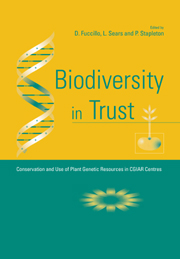7 results
Frontmatter
-
- Book:
- Biodiversity in Trust
- Published online:
- 22 September 2009
- Print publication:
- 28 August 1997, pp i-vi
-
- Chapter
- Export citation
Contributors
-
- Book:
- Biodiversity in Trust
- Published online:
- 22 September 2009
- Print publication:
- 28 August 1997, pp xi-xii
-
- Chapter
- Export citation
Contents
-
- Book:
- Biodiversity in Trust
- Published online:
- 22 September 2009
- Print publication:
- 28 August 1997, pp vii-viii
-
- Chapter
- Export citation

Biodiversity in Trust
- Conservation and Use of Plant Genetic Resources in CGIAR Centres
-
- Published online:
- 22 September 2009
- Print publication:
- 28 August 1997
Index
-
- Book:
- Biodiversity in Trust
- Published online:
- 22 September 2009
- Print publication:
- 28 August 1997, pp 349-372
-
- Chapter
- Export citation
Acronyms
-
- Book:
- Biodiversity in Trust
- Published online:
- 22 September 2009
- Print publication:
- 28 August 1997, pp xiii-xvi
-
- Chapter
- Export citation
Preface
-
- Book:
- Biodiversity in Trust
- Published online:
- 22 September 2009
- Print publication:
- 28 August 1997, pp ix-x
-
- Chapter
- Export citation



